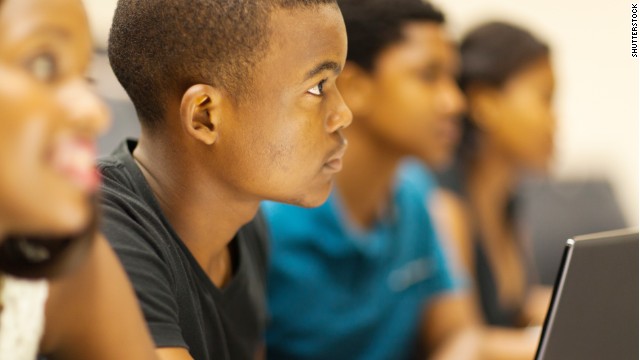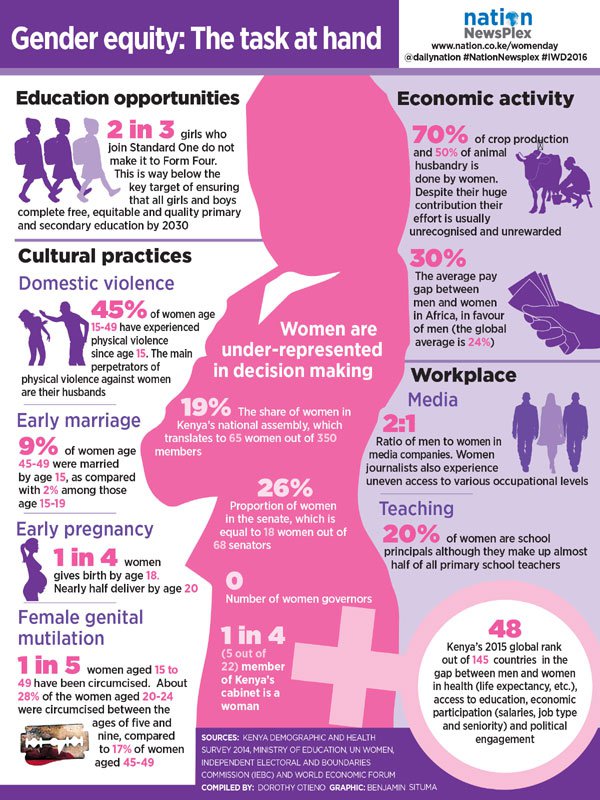In Summary
- Not a single county governor is a woman, and only a quarter of President Uhuru Kenyatta’s cabinet consists of women.
- National Assembly, 65 out of 350 seats (19 per cent) are held by women, despite affirmative action measures that guaranteed women 47 seats in the 2013 General Election.
- Women are responsible for 70 per cent of crop production, 50 per cent of animal husbandry and 60 per cent of marketing.
The odds against women in Kenya remain stacked high despite the enactment of laws and interventions aimed at ensuring gender equity.
Women and girls make up more than half the world’s population and their socio-economic contributions and leadership are central to achieving sustainable development. As the world marks International Women’s Day on March 8, the focus will be on building momentum for effective implementation of the Sustainable Development Goals (SDGs), designed to end poverty and hunger.
Of particular interest on this day are goal number five, on the social, economic, cultural and political achievement of women, and goal number four, on ensuring quality education and lifelong learning opportunities.
Nation Newsplex took a look at how far women in Kenya have come in achieving some of the key targets of the 2030 Agenda.
Below are facts on gender inequality in Kenya, sourced from the Kenya Demographic and Health Survey 2014, Ministry of Education, UN Women, International Women’s Media Foundation, the Independent Electoral and Boundaries Commission (IEBC) and the World Economic Forum (WEF).
How many girls complete basic education?
About two in three girls who join Standard One do not complete Form Four, which is way below the key target of ensuring that all girls and boys complete free, equitable and quality primary and secondary education by 2030.
How well are women represented in decision making?
More than five years since the Constitution was promulgated, women’s participation in political processes and representation in decision making has remained muted. Not a single county governor is a woman, and only a quarter of President Uhuru Kenyatta’s cabinet consists of women.
In the National Assembly, 65 out of 350 seats (19 per cent) are held by women, despite affirmative action measures that guaranteed women 47 seats in the 2013 General Election. Kenya’s supreme law requires that no more than two-thirds of people elected or appointed to public bodies consist of one gender.
The Senate, with 18 women senators out of 68, also falls short of the two-thirds gender rule. Every female senator made it to the upper house through seats allocated solely to women in the Constitution and through nominations by political parties to represent special interests.
In the public service, a third of principal secretaries (15 out of 41) are women. The county assemblies met the two-thirds gender rule, although it was forced on them by electoral laws. In the case of the other legislative bodies and Cabinet, Bills were to be passed and policies developed to operationalise the rule.
Which socio-cultural practices hold back women?
Nearly half (45 per cent) of women age between 15 and 49 and 44 per cent of men aged between 15 and 49 have experienced physical violence since 15 years of age.
The main perpetrators of physical violence against women are husbands, whereas the main perpetrators against men are teachers and parents, according to the 2014 KDHS. Twice as many women as men have experienced sexual violence at least once in their lifetime.
Elimination of all forms of violence against all women and girls in the public and private spheres, including trafficking and sexual and other types of exploitation is one of the SDG targets.
One in five women aged between 15 and 49 have been circumcised. About 28 per cent of women aged between 20 and 24 were circumcised between the ages of five and nine, compared to 17 per cent of women aged 45-49. Another key target of SDGs is to eliminate all harmful practices, such as child marriage, early and forced marriage and female genital mutilation.
What is Kenya’s global rank on gender inequity?
According to the 2015 Global Gender Gap report, Kenya is ranked 48 out of 145 countries in the global gender index that considers the gap between men and women in economic participation (salaries, job type and seniority), political engagement, access to education and health (life expectancy, mortality etc.).
Kenya dropped 11 places on the overall rankings last year, mostly due to a decrease in both the wage equality for similar work and a reduction in women in the Cabinet.
What is the situation in the workplace?
In media companies, the ratio of men to women is 2:1. Women journalists also experience uneven access to the various occupational and managerial levels of the industry.
In the education sector, women make up 20 per cent of women school principals even if almost half of all primary school teachers are women.
How much do women contribute to the economy?
Women are responsible for 70 per cent of crop production, 50 per cent of animal husbandry and 60 per cent of marketing. Despite their huge contributions their efforts usually go unrewarded and unrecognised.
According to UN Women, agricultural activities undertaken by African women are typically characterised by a lack of resources and support such as credit, agricultural inputs, and the technologies necessary to increase production.


